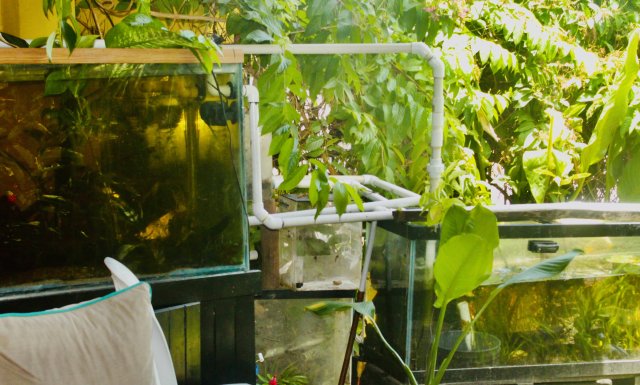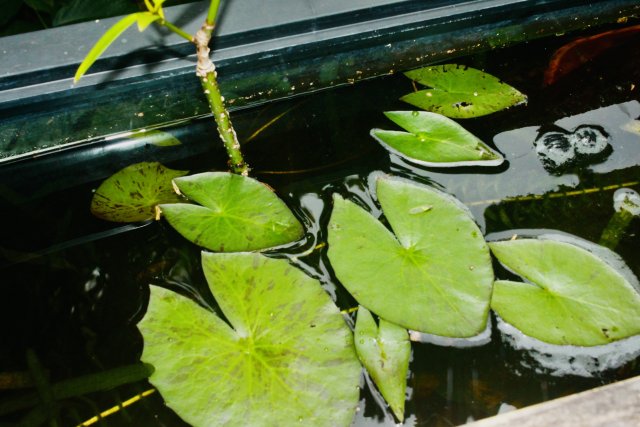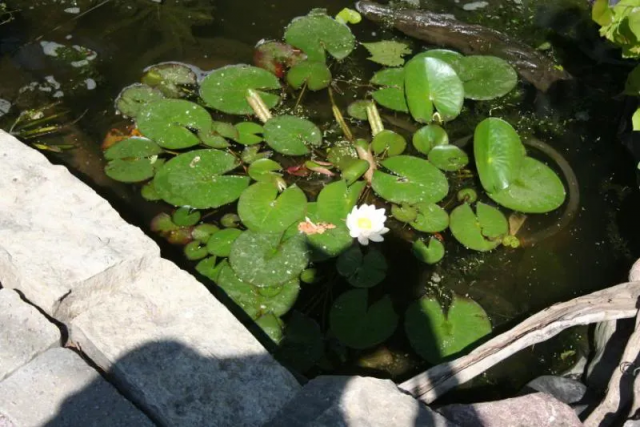I was checking the temp of my 40g outdoor pond with 1 common gold fish and a few guppies in it today, and found it was pushing 85 degrees. I know gold fish and guppies generally do well in unheated tanks, and began to wonder how does fish in wild handle daily temp fluctuation and would it be a good idea to replicate for the aquarium fish? I would assume with the much much much larger water body, it would be way better to hold daily water temperature rather stable, and fish can swim upper/deep to find warmer/hotter water, but would still imagine a peak difference of a few degrees (i.e. from direct sun at noon vs midnight). would aquarium need this? how about daily vs seasonal?
aquarium fish expose to daily temp fluctuation?
- Thread starter ruincccc
- Start date
You are using an out of date browser. It may not display this or other websites correctly.
You should upgrade or use an alternative browser.
You should upgrade or use an alternative browser.
It will be interesting to see how this thread develops. I started one some time ago addressing the exact same thing but it didn't gain much interest. I was surprised because it's a valid concern.
To the best of our ability we all try and replicate in our tanks what the fish would go through in the wild, but where temperatures are concerned I doubt many do at all.
We all have our heaters set at a certain temp and I bet most of us just leave that setting alone for the whole 365 days of the year.
But like you said, not only are there wild swings in temps on a seasonal scale, but even day and night too.
Really, when you think about it, heaters should be on timers, or turned down at least, even on a daily basis to replicate the cooling down of night time. Summer and winter times would need to be taken into consideration too.
But then again, large bodies of water have small incremental gradual changes which fish adapt to with ease. Water in an aquarium can warm up/cool down quite quickly, and this can be problematic in small puddles such as our tanks.
Maybe it is better to rely on heaters to keep our tanks stable at all times rather than faff about and ultimately cause our fish potential unnecessary stress due to constant wild fluctuations in temps.
Interesting.
To the best of our ability we all try and replicate in our tanks what the fish would go through in the wild, but where temperatures are concerned I doubt many do at all.
We all have our heaters set at a certain temp and I bet most of us just leave that setting alone for the whole 365 days of the year.
But like you said, not only are there wild swings in temps on a seasonal scale, but even day and night too.
Really, when you think about it, heaters should be on timers, or turned down at least, even on a daily basis to replicate the cooling down of night time. Summer and winter times would need to be taken into consideration too.
But then again, large bodies of water have small incremental gradual changes which fish adapt to with ease. Water in an aquarium can warm up/cool down quite quickly, and this can be problematic in small puddles such as our tanks.
Maybe it is better to rely on heaters to keep our tanks stable at all times rather than faff about and ultimately cause our fish potential unnecessary stress due to constant wild fluctuations in temps.
Interesting.
Large swings over short periods can be detrimental or lethal for fish. Larger volumes and deeper water are significantly more stable in temperature as you said, and may be better for outdoor fish due to the rapid heating the sun can cause. If not in the sun it probably would not be a large issue.
In nature very few fish would live for any amount of time in only 40 gallons of water, basically not much more than a puddle.
One of the reasons they wouldn't , is that such a tiny volume of water would be subject to those volatile temp swings mentioned above.
Fish kills during sumner heat waves are common in thousands (even millions) of gallons, and common in small lakes in places like northern WI, in these days of drastic climatic deviations.
In the 90s I kept a 50 gal tank in my back yard in WI, where daily water temps would hit 80sF and night temps drop in the 50sF.
I found the only way I could keep a reasonably stable enough environment to maintain the fish I like, was to use my 1500 gal shaded pond as a sump.
Photos below

My outside set up theses days in Panama is similar.(below)
My 180 gal main tank, is set up under the shade of a patio roof, with only the 125 gal heavily planted sump/refugium set up in partial sun.
If the power goes out, shutting down the recirculating pump action between the two tanks, the sump overheats very quickly late morning.

So I use of water lilies in the sump as a natural way to add shade, helps by soaking up direct sun that would easily over heat it..

I found using water lilies to be an invaluable tool as a natural water temp regulator, even in my larger ponds in WI.
Below

Moving water also remains a tad cooler.
A smaller pond in the 2 videos below (about 500 gallons, in WI) in partial shade using lilies, and Hyacinth for added shading, and moving water to help stabilize temp
koi pond fractionation
GOPR6064
One of the reasons they wouldn't , is that such a tiny volume of water would be subject to those volatile temp swings mentioned above.
Fish kills during sumner heat waves are common in thousands (even millions) of gallons, and common in small lakes in places like northern WI, in these days of drastic climatic deviations.
In the 90s I kept a 50 gal tank in my back yard in WI, where daily water temps would hit 80sF and night temps drop in the 50sF.
I found the only way I could keep a reasonably stable enough environment to maintain the fish I like, was to use my 1500 gal shaded pond as a sump.
Photos below

My outside set up theses days in Panama is similar.(below)
My 180 gal main tank, is set up under the shade of a patio roof, with only the 125 gal heavily planted sump/refugium set up in partial sun.
If the power goes out, shutting down the recirculating pump action between the two tanks, the sump overheats very quickly late morning.

So I use of water lilies in the sump as a natural way to add shade, helps by soaking up direct sun that would easily over heat it..

I found using water lilies to be an invaluable tool as a natural water temp regulator, even in my larger ponds in WI.
Below

Moving water also remains a tad cooler.
A smaller pond in the 2 videos below (about 500 gallons, in WI) in partial shade using lilies, and Hyacinth for added shading, and moving water to help stabilize temp
koi pond fractionation
GOPR6064
Last edited:
IMO creating a stable and consistent environment is more beneficial than trying to “replicate the wild”… my fish highly benefited from auto drip systems because of the consistency and lack of change in water parameters, temp fluctuations and even the stress from water changes in general. Everyone boasts “bigger tanks are better”… this is not really true. Bigger tanks provide more stability and less change therefore less error. Its just a “bandaid” tho… water can still be bad in larger systems over time… You can still provide the same thing in a smaller tank with automation.
In the “wild”… water is far more stable than air temperatures. It takes months even for temps to rise or drop even a few degrees. Sure the top 2” or even foot of a water column may experience temp fluctuations but the main body of water stays pretty consistent. Ive fished plenty 30 degree days in winter where the water is still 50 degrees. The same goes for spring/summer where air temps are 80-90 and the water is mid 60’s…
In the “wild”… water is far more stable than air temperatures. It takes months even for temps to rise or drop even a few degrees. Sure the top 2” or even foot of a water column may experience temp fluctuations but the main body of water stays pretty consistent. Ive fished plenty 30 degree days in winter where the water is still 50 degrees. The same goes for spring/summer where air temps are 80-90 and the water is mid 60’s…
In virtually any aquarium, we also create water movement by means of pumps or airstones, which in such a small body of water ensures thorough mixing and an equalization of temperature throughout the tank. In a swift-flowing stream in nature, a similar uniformity of temperature exists throughout.
But a slow-moving or stagnant body of water in nature, or in an outdoor pond, exhibits very marked temperature differentials between top and bottom, and the fish are free to move between these areas and can find the temperatures that best suit them. My outdoor stock tanks are completely stagnant...oh, the horror!...and the temperature can vary by many degrees between top and bottom, especially in the sunshine. The topmost water also experiences large swings in temperature in a single day between midnight and midday, whereas the bottom layer is much more stable. Fish will often hang out in that stable bottom area, but still dart to the surface...i.e into that very warm layer...for a brief moment to feed.
When I tried using aeration/filtration in those same stock tanks, it was an abysmal failure; instead of merely the top few inches of water becoming uncomfortably warm (and oxygen-poor) under the hot summer sun, the entire body became so. Back to nice, comfortable stagnant water for me!
When you observe something firsthand, happening in front of your eyes in your own tanks, I think it's a great idea to try to analyze it, understand it, explain it and gain knowledge from it. But...sometimes the overthinking that goes on here is...well, bordering on silly.
One of my first employers would often roar "Don't think! DO!!!!" I'm not suggesting that...but maybe a little more "doing" and a little less "plotting and fantasizing" is sometimes in order.
I'm not suggesting that...but maybe a little more "doing" and a little less "plotting and fantasizing" is sometimes in order. 
But a slow-moving or stagnant body of water in nature, or in an outdoor pond, exhibits very marked temperature differentials between top and bottom, and the fish are free to move between these areas and can find the temperatures that best suit them. My outdoor stock tanks are completely stagnant...oh, the horror!...and the temperature can vary by many degrees between top and bottom, especially in the sunshine. The topmost water also experiences large swings in temperature in a single day between midnight and midday, whereas the bottom layer is much more stable. Fish will often hang out in that stable bottom area, but still dart to the surface...i.e into that very warm layer...for a brief moment to feed.
When I tried using aeration/filtration in those same stock tanks, it was an abysmal failure; instead of merely the top few inches of water becoming uncomfortably warm (and oxygen-poor) under the hot summer sun, the entire body became so. Back to nice, comfortable stagnant water for me!
When you observe something firsthand, happening in front of your eyes in your own tanks, I think it's a great idea to try to analyze it, understand it, explain it and gain knowledge from it. But...sometimes the overthinking that goes on here is...well, bordering on silly.
One of my first employers would often roar "Don't think! DO!!!!"
This is what some don't consider when they talk about water temperature changes in the wild. Also, as an observant fisherman knows, even in a lake or moving stream fish may move during the day, move to accommodate hot or cold days, or move seasonally according to conditions. Different fish have different comfort levels as far as range or variation of temperature.But a slow-moving or stagnant body of water in nature, or in an outdoor pond, exhibits very marked temperature differentials between top and bottom, and the fish are free to move between these areas and can find the temperatures that best suit them.
Some respond to positively to cool water changes by spawning. Certain of my tanks fluctuate by 2-3 degrees daily via the sun coming in vs cooler at night and it doesn't bother my fish. However, extremes (too rapid or repeatedly large swings) tend to be stressful or detrimental imo.
great inputs and discussion.
the 40g pond I have was more for a small fountain feature, that I had to use to house the goldfish my little boy insisted on buying from Petco. I honestly don't care too much about this pond, as the fish in it appears to be doing fine and don't expect Seattle summer/winter to be that harsh.
I was more referring to my other indoor aquariums, I was thinking maybe 1 primary heater always set at 77 degrees, while a secondary at 79 and will turn off during the night with a timer, and changing to 75 and 77 respectively in the winter. so the worst temp fluctuation can be no greater than 2 degrees. that may help trigger natural seasonality and spawning behavior in the fish?
again I wasn't seeing a pressing or super valid need for me to implement such, it was just an interesting idea that popped into my mind
the 40g pond I have was more for a small fountain feature, that I had to use to house the goldfish my little boy insisted on buying from Petco. I honestly don't care too much about this pond, as the fish in it appears to be doing fine and don't expect Seattle summer/winter to be that harsh.
I was more referring to my other indoor aquariums, I was thinking maybe 1 primary heater always set at 77 degrees, while a secondary at 79 and will turn off during the night with a timer, and changing to 75 and 77 respectively in the winter. so the worst temp fluctuation can be no greater than 2 degrees. that may help trigger natural seasonality and spawning behavior in the fish?
again I wasn't seeing a pressing or super valid need for me to implement such, it was just an interesting idea that popped into my mind


